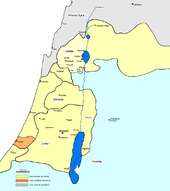Machaerus
Machaerus , actually Machairous, ( Greek Μαχαιροῦς , also Machärus ) was, like the fortresses Alexandreion , Dok (Dagon), Hyrkania , Masada or Herodium , a castle of Herod the Great .
location
The castle complex is located on a conical mountain east of the Dead Sea in present-day Jordan near the old Frankincense Route (northeast route). In ancient times the castle guarded the Judean - Nabataean border area of the Jewish province of Perea .
“(165) Macharus had all the qualities to instill in his defenders the firmest confidence in victory, but in a siege army strong misgivings and even horror. (166) The walls of the actual fortress stood on a rocky, skyward height, which for this reason alone is difficult to storm. (167) Moreover, it is so naturally fortified by its surroundings that it cannot even be made accessible by appearing blocked off in all directions by wild gorges, as if by natural ditches, namely gorges of such depth as that the eye cannot get down to their bottom at all, and the foot can only find a way through them with difficulty: to cut them with a dam is utterly impossible. (168) The ravine that Macharus closes off in the west runs sixty stadiums and only ends at the asphalt lake . And it is precisely on this side that the height of Macharus extends its steepest horn. (169) The subsidence in the north and south, although not as extensive as the one just mentioned, presents much the same difficulties for an attack. (170) The eastern ravine, on the other hand, despite its depth, which is certainly not less than a hundred cubits, nevertheless reaches its end right at the mountain which is directly opposite Macharus. "
“The asphalt lake generates nothing but bad luck, which is where it got its name from. It devours no animal body, even bulls and camels swim on it; hence the legend comes that nothing sinks under it. Its length is over 100,000 paces, its greatest width 25,000, its smallest 6000 paces. On its eastern bank lies the nomadic Arabia, on its southern Macharus, once the most important fortress in Judea after Hierosolyma. On the same side is the hot healing spring, Callirhoë (the beautifully flowing one), whose name already proclaims the fame of its water. "
history
Flavius Josephus recounts Machaerus both in his History of the Jewish War and in the Jewish Antiquities . According to this, the Hasmonean Alexander Jannäus built a first fortification here ( Bellum Judaicum 7, 171), which was destroyed by Aulus Gabinius in the war with Aristobulus II . Josephus reports that Aristobulus retreated here with 8,000 armed men, of whom 5,000 fell in an initial meeting and 2,000 deserted. The remaining 1000 holed up in the fortress ( Bellum Judaicum 1, 171).
Herod the Great restored the ruins ( Bellum Judaicum 7, 172–177). In the Jewish Antiquities , Flavius Josephus reports on the violent death of John the Baptist . There it says in 18, 119, "Herod [had] John put in chains, brought to the fortress of Machaerus ... and executed there." The biblical passages in which the death of John is reported do not localize the event. After Agrippa's death (44 AD), the complex came into the possession of the Roman prefect of Judea.
When the Jewish uprising broke out (66 AD), rebels occupied Machaerus ( Bellum Judaicum 2, 485–486). The legate Lucilius Bassus came after conquering the fortress of Herodium, besieged the fortress with the Xth Legion and other armies, and began to raise a dam, which caused casualties of the besieged. The capture of the defender Eleazar, who is characterized by particular arrogance, finally caused the crew to hand over the fortress ( Bellum Judaicum 7, 163-209).
Remarks
- ↑ The Jewish War . Translation by Philipp Kohout ( Wikisource )
- ^ Translation after Philipp Hedwig Külb , 1840
swell
- Pliny the Elder : Naturalis historia 5, 17.72
- Flavius Josephus:
- Bellum Judaicum 1, 161, 167, 171-173; 2,485; 3, 46; 4,439,555; 7, 164-177. 190-209
- Antiquitates Judaicae 13, 417; 14, 89; 18, 119
literature
- Günther Garbrecht, Ehud Netzer : The water supply of historical desert fortresses in the Jordan Valley. In: Wiel Dierx, Günther Garbrecht: Water in the Holy Land. Biblical evidence and archaeological research. Philipp von Zabern, Mainz 2001, pp. 222-239.
- Ehud Netzer: The palaces of the Hasmoneans and Herod the great. Philipp von Zabern, Mainz 1999, ISBN 3-8053-2011-6 , p.?.
- August Strobel : Machärus - history and end of a fortress in the light of archaeological-topographical observations . In: Siegfried Wagner (ed.): Bible and Qumran. Festschrift for Hans Bardtke . Evangelische Haupt-Bibelgesellschaft, Berlin 1968, pp. 198–225
- August Strobel: The Roman siege work around Machärus. Topographic surveys . In: Journal of the German Palestine Association 90 (1974), pp. 128-184
- Győző Vörös (ed.): Machaerus I: History, Archeology and Architecture of the Fortified Herodian Royal Palace and City Overlooking the Dead Sea in Transjordan ( Studium Biblicum Franciscanum : Collectio Maior 53). Edizioni Terra Santa, Milano 2013.
- Győző Vörös (ed.): Machaerus II: The Hungarian Archaeological Mission in the Light of the American-Baptist and Italian-Franciscan Excavations and Surveys (Studium Biblicum Franciscanum: Collectio Maior 55). Edizioni Terra Santa, Milano 2015.
- Győző Vörös (ed.): Machaerus III: The Golden Jubilee of the Archaeological Excavations (Studium Biblicum Franciscanum: Collectio Maior 56). Edizioni Terra Santa, Milano 2019.
Web links
Coordinates: 31 ° 34 ′ 1 ″ N , 35 ° 38 ′ 1 ″ E

